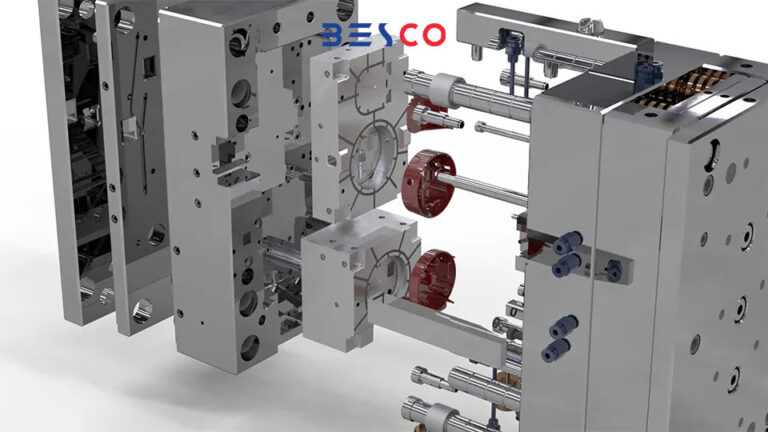How is plastic injection mold design and construction done?
Plastic injection mold manufacturing and construction is a complex, multi-step procedure that requires precision and high technical skills. The steps involved in the process are described below:

How is plastic injection mold design?
Plastic injection mold design is a detailed, multi-step process that starts with analyzing the product requirements, including material selection, dimensional accuracy, and surface finish. Using advanced CAD and CAM software, designers create detailed 3D models and plan the mold’s core, cavity, and cooling systems.
Once the design is finalized, the mold is precisely manufactured using CNC machines, followed by assembly and testing on an injection molding machine to ensure it meets specifications. Continuous optimization and maintenance are essential to ensure the mold operates effectively, producing high-quality, defect-free parts in mass production.
Requirements Analysis
The very first job when making an injection mold is the requirement analysis of the final product. It’s to verify the type of plastic used, precision of size, finish on the surface, and the mechanical durability of the product. Designers in this process need to consider every customer requirement so that they may design an adequate mold.
Conceptual Mold Design
In this step, the initial mold design is created. The design includes the filling of the mold, cooling system, and part ejection mechanisms. Designers use CAD (Computer-Aided Design) software to create 3D models. The models help designers identify potential problems before the mold is produced.
Deep Mold Design
After reaching the conceptual design, designers move on to deep design. Here, the proper design of various parts of a mold such as core, cavity, runner system, and cooling system is undertaken. In this stage, planning of machining using CAM software takes place.
Mold Manufacturing
Once the design is complete, the process of mold manufacturing follows. Machining of all the mold parts on CNC machines is the process. There must be absolute precision at this stage because minute errors will yield defective parts.
Assembly and Mold Testing
After the mold parts are manufactured, they are assembled, and the entire mold is tested. The mold is placed on the injection molding machine, and a few test parts are produced. The parts are inspected to verify the mold is performing as intended and the parts produced are to the specifications desired.
Mold Optimization and Realignment
When there are any issues with the parts that have been manufactured, the mold is optimized and realigned. This may be through mold design change or changing the injection molding equipment settings. The objective of this phase is to manufacture high-quality, defect-free parts.
Mass Production
Once the mold is finally approved, mass production begins. In this process, the mold is repeatedly run in the injection molding machine to produce plastic parts. These parts are then moved to assembly lines for final product assembly.
Key Points in Mold Design and Construction
- Material Selection: Care should be taken to choose the appropriate material for building molds. The materials must have high resistance and also good machining characteristics.
- Cooling System: Application of a good cooling system can reduce cycle time and improve part quality manufactured.
- Part Ejection Mechanisms: The part ejection mechanism should be designed to safely permit parts to be ejected simply and securely from the mold without damage.

To enable the required precision and alignment of mold components during its working life, different methods and techniques are employed:
Preventive and Routine Maintenance
Regular and preventive maintenance is one of the most important things in maintaining the accuracy of mold components. This includes routine checking and cleaning of mold components, replacing faulty parts, and ensuring proper lubrication. These are some of the practices that help in avoiding premature wear and failure of parts.
Using High-Quality Materials
Utilization of high-quality materials for mold components is an important aspect in maintaining their precision and alignment. High-wear and corrosion-resistant materials increase the service life of the mold and guarantee component accuracy.
Temperature Control and Sufficient Cooling
Proper temperature management and cooling throughout the injection molding process prevent warping and contraction of mold parts. Cooling arrangements should be sufficient to maintain mold temperature within its correct range.
Applying Advanced Technologies
Employing advanced technologies like CNC machines and CAD/CAM software increases the accuracy of mold component production. These technologies allow for producing parts with a high degree of accuracy and precise alignment.
Periodic Inspection and Calibration
Periodic inspection and calibration of the mold parts help detect and correct any mistakes or deviations. It should be conducted regularly to make sure that the mold parts keep working with the same precision and alignment as when they were designed.
Training and Employee Skill Development
Training and employee skills development must also play an important part in mold precision. The proper techniques for mold repair and maintenance need to be known by employees, and they must be able to recognize and correct defects as they occur.
